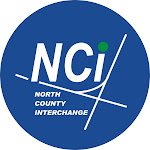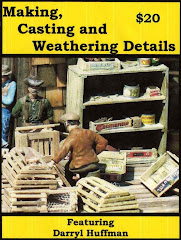(Text by Paul; pictures by Rick)
Another productive night on the San Pablo, Sonora, & Fresno! Rick, Steve, Ken, and Bob showed up, and I got to show off the progress I've made on setting the route for the narrow gauge main line on the upper level. Then we cleaned off the table that Donna and I had filled with eBay and train show stuff so we'd have a place to work. Our first project turned out to be making 4 plywood bases for gingerbread houses for Donna to have her girls' reading class decorate. She was happy with Bob's work, and the rest of us unloaded the plywood from the pickup truck and brought it down to the basement. Then we discussed the parameters of going up one more level on the helix. Bob and Steve stuck a 2X2 across the helix opening, and Bob used his beam compass to generate a center for a 42" radius curve, and we made sure the outer edge of the proposed curve fit within the constraints of the existing structure. Bob and I figured out the needed inner and outer radii. Then we brought one of the plywood sheets in to the table, and we traced the inner and outer radii of the helix curve onto the plywood surface. Bob was trying to minimize waste, so the first curve started at the corner of the sheet, but I wanted a full semi-circle, so we relocated the center to the middle of the bottom edge, and we drew the complete arc. Ken the Wise suggested we draw a series of short arcs of the correct radii on the portion of the sheet inside the full semi-circle, so Bob got to show off his geometry expertise by located a series of different centers along an entirely separate arc, and we got half a dozen partial circles in the available area - enough to make an entire semi-circle, probably. Then we brought in the other full sheet, and drew a single semi-circle on it. I'll cut out the figures tomorrow in the daylight outside.
We had gone to Costco earlier today, and they had strawberry cheesecake cakes on sale, so that - plus strawberries and grapes - was what we had for snacks. The cake went pretty early...
Rick and Ken left a little early, so Bob, Steve, and I looked some more at the splines I've completed on the narrow gauge, since Steve is considering using splines on his upcoming layout. The 3 of us actually installed a spline along the wall so Steve could see how it's done. As I was finishing installing the clamps, Bob and Steve decided to measure how long the narrow gauge main line actually is. And they came up with 100' 2", or 1.65 scale miles. We discussed where the operating features would be located, and operating schemes to be used. Lots of fun! I always enjoy these work nights, because so much of what we need to get done is much more difficult when we work alone. Some of it is impossible alone, but is fun and goes quickly with a group of like-minded model railroaders each sharing their expertise and experience and point of view.
And next week we get to move Ken's layout to his new palace!
Paul








